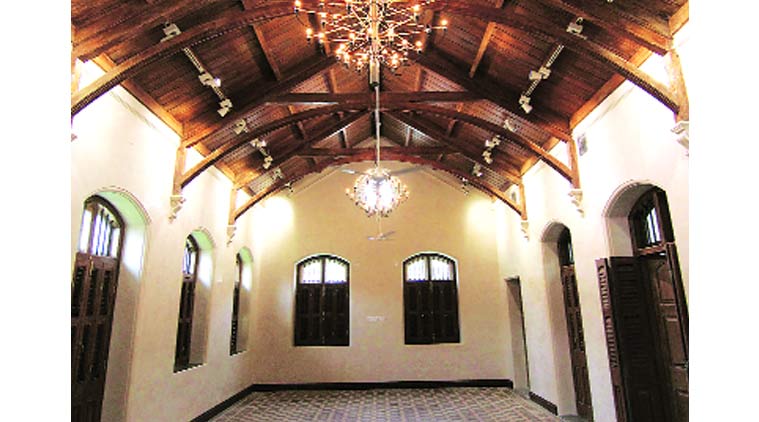- India
- International
SNDT Women’s University Turns 100 : 3 years after it was shut down, Kanyashala stands tall again
All-women team resurrects building part of S-E Asia’s 1st women’s university.
 the interiors of the restored Kanyashala building. (Source: Express Photo by Amit Chakravarty)
the interiors of the restored Kanyashala building. (Source: Express Photo by Amit Chakravarty)
When a Girgaum building constructed in the 20th century closed its doors in 2012, it was just another dilapidated building among South Mumbai’s hundreds.
But now, the Damodar Thackersey Kanyashala near Charni Road, once a pioneering player in the movement to educate girl children, has been restored by just those it was meant to enlighten, a group of women.
The Kanyashala building is part of the Shreemati Nathibai Damodar Thackersey (SNDT) Women’s University that is also India’s and South-East Asia’s first women’s university. With the institution completing 100 years Sunday, its restoration takes greater significance.
It was a common vision to restore the historical building that brought together chairperson of the JSW Foundation Sangita Jindal (the donor for the restoration project), SNDT University Vice-Chancellor Dr Vasudha Kamat and conservation architect Abha Narain Lambah. What’s more, the restoration project was also completed by an all-women team of architects and coordinators.
[related-post]
The building has special relevance for SNDT as it was one of the first institutions dedicated towards the education of girls. Now, we hope to continue with this endeavor by using this building for the purpose of teaching art to women as SNDT celebrates its 100 years,” says Kamat.
The work of restoring the building began in 2014. The conservation work is now almost complete and, following finishing touches, will be inaugurated in August as the SNDT University — Jindal Centre for the Arts. SNDT will hold undergraduate and postgraduate painting and drawing courses from here during the day while the building will turn into a hobby centre in the afternoons.

“I feel working towards protecting and conserving heritage is very important. An opportunity was presented to work towards conserving this building when Gayatri Mehta, an artist friend, told me about this building. SNDT will hold their classes and we will hold hobby classes in the evening,” says Jindal. The building will also have an art gallery.
The Kanyashala’s historical relevance cannot be understated. Originally the residence of reformist Maharshi Dr Dhondo Keshav Karve, it was turned into a Marathi-medium school for girls. Over the years, the school shut down due to various reasons and the building aged without proper upkeep. SNDT used the building for some of its post-graduate arts classes till the building could not be used any further.
Mehta, a student of SNDT College who pursued her post-graduation in 2011-12, studied in the Kanyashala building for a while till they had to move out as parts of the building had started to crumble. “I was fascinated by the building, which is almost 130 years old. But it eventually shut down and over the years was in very bad shape,” says Mehta, a consultant coordinator for the project.
Since she knew the V-C of the university and Sangita Jindal, they all came together and a memorandum of understanding was signed in 2012, she says.
The Damodar Thackersey Kanyashala is a Grade III structure listed in the Heritage Regulations for Greater Bombay 1995.
With similar buildings in its immediate neighbourhood, the building is built on the lines of an English mansion, with ground plus three storeys. At the upper level, the building has long running balconies and supported with a sloping Mangalore-tiled roof giving it a vernacular feature.
When we first visited the site, the structure was in a very dilapidated condition and the balconies were collapsing. This structure has a vernacular, neo-classical style of architecture with wooden balconies and a Burma Teak roof, which was waterproofed. We retained the tiles wherever they still existed and scraped the paint from the windows and doors,” Lambah says about the structure.
ruhi.bhasin@expressindia.com
Apr 25: Latest News
- 01
- 02
- 03
- 04
- 05







































